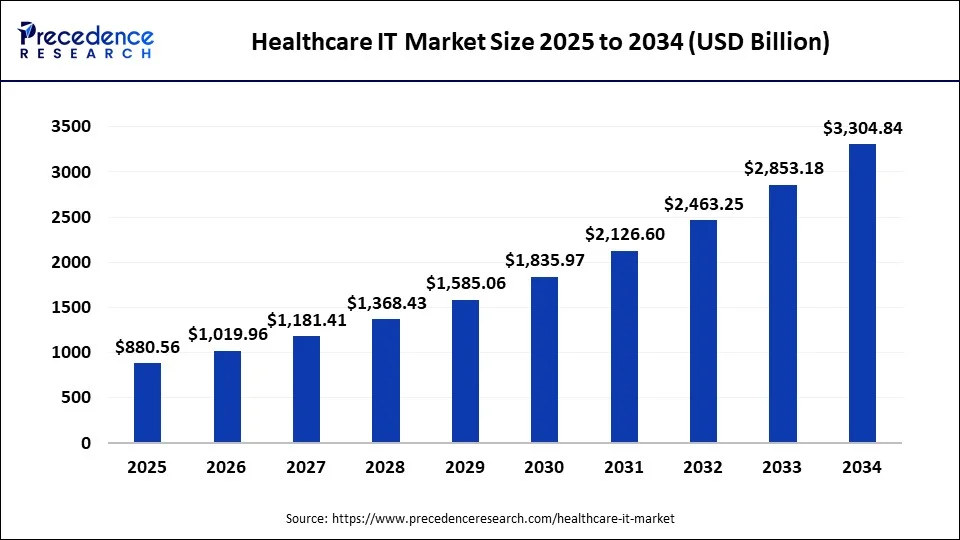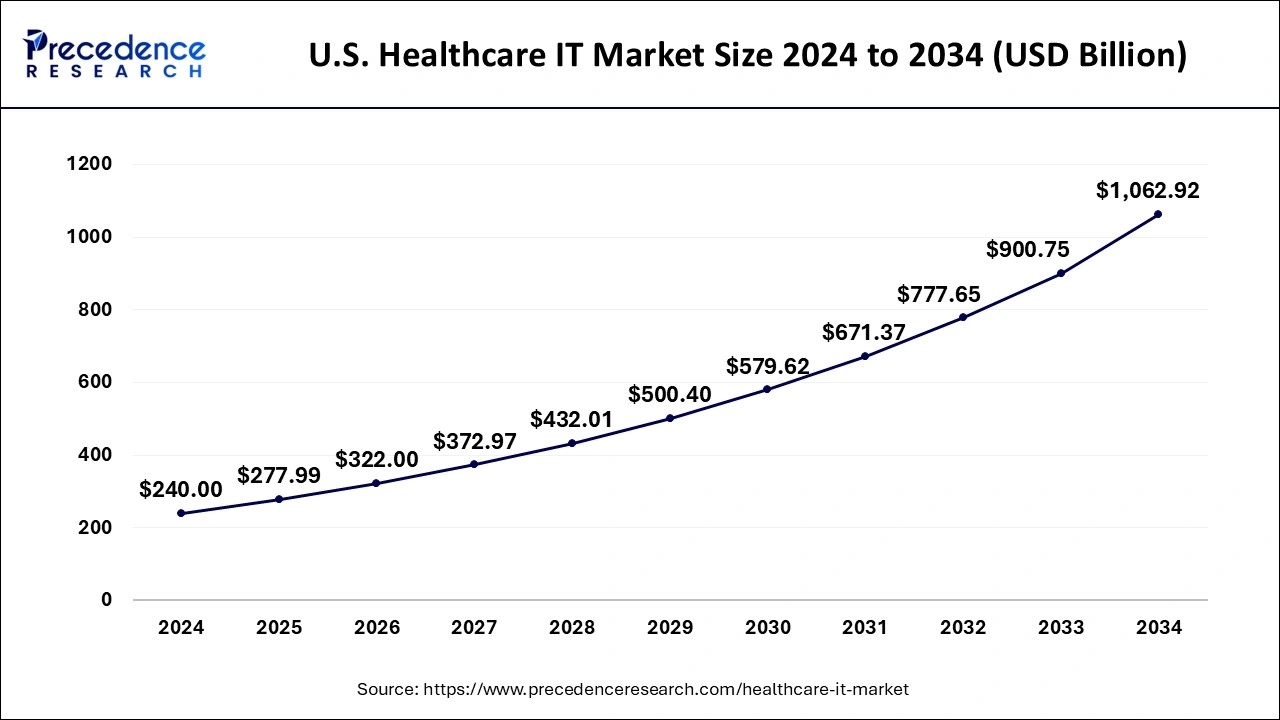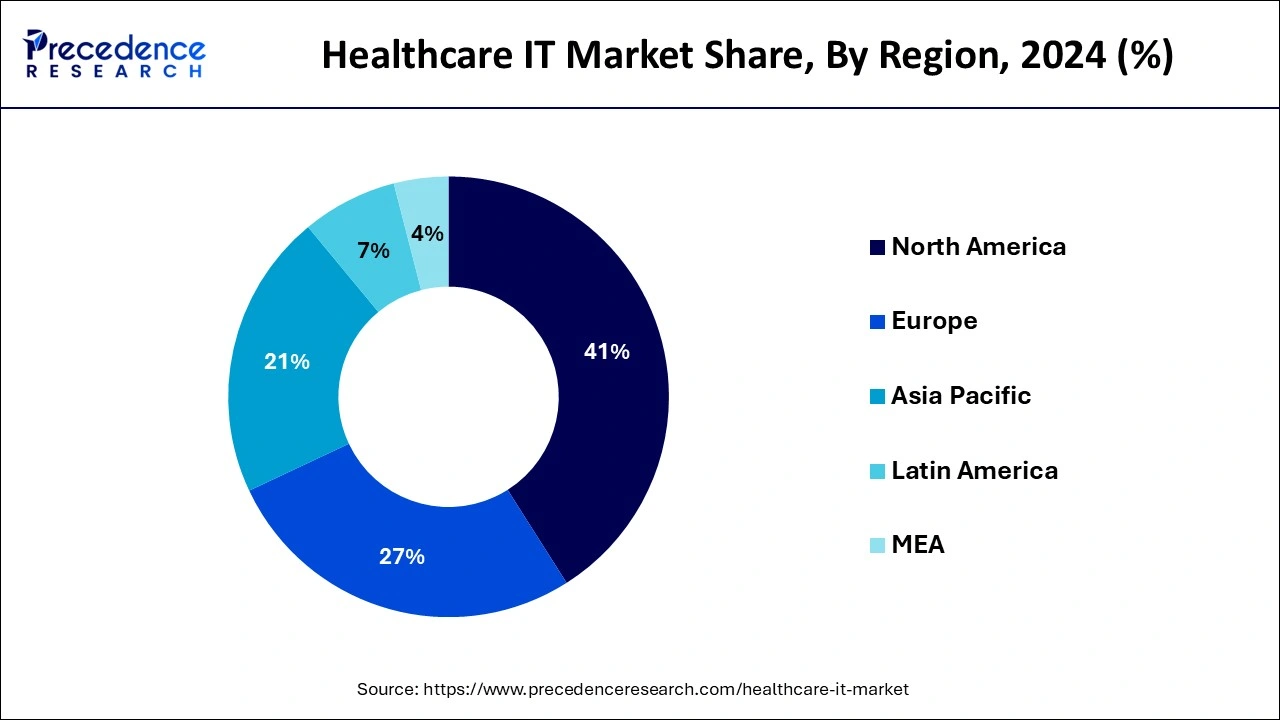January 2025
The global healthcare IT market size was USD 760.22 billion in 2024, estimated at USD 880.56 billion in 2025 and is anticipated to reach around USD 3304.84 billion by 2034, expanding at a CAGR of 15.83% from 2025 to 2034. The North America healthcare IT market size was calculated at USD 311.79 billion in 2024 and is expected to grow at a fastest CAGR of 15.97% during the forecast year.
The global healthcare IT market size accounted for USD 760.22 billion in 2024 and is predicted to be worth around USD 3304.84 billion by 2034, growing at a CAGR of 15.83% from 2025 to 2034.

Artificial intelligence revolutionized the healthcare domain by impacting its several divisions and providing assistance in surgeries, diagnostics, personalized treatment plans, etc. AI-powered tools and techniques help to improve radiology, medical imaging, and drug discovery and development. AI assistance ensures remote patient monitoring and telemedicine approaches. It also ensures administrative automation in routine tasks in healthcare with the help of natural language processing (NLP) systems. The NLP systems and AI help to improve doctor-patient conversations, and reduce paperwork and administrative tasks. AI also helps to interpret medical imaging data, X-rays, CT scans, and MRIs.
The U.S. healthcare IT market was valued at USD 240 billion in 2024 and is predicted to be worth around USD 1062.92 billion by 2034, growing at a CAGR of 16.04% between 2025 to 2034.

North America dominated the market with revenue share of 41% in 2024. Due to the growing rate of consumer adoption, strong buying power, increased access to digital technologies, and higher adoption of the Internet and smart devices. The presence of strong healthcare information technology organizations in North America drives the efforts to improve the safety, efficiency, quality, and effectiveness of healthcare for all American people. The American Health Information Management Association (AHIMA) works as the premier association of health information management (HIM) professionals. About 52,000 AHIMA members are dedicated to managing personal health information effectively to deliver promising healthcare to the population. The American Medical Informatics Association (AMIA) is committed to biomedical research and health informatics. About 4,000 members of AMIA are dedicated to implementing health information and communication technology in clinical research, clinical care, personal health management, public health, and translational science.
The American Nursing Informatics Association (ANIA) aims to provide education, networking, and information resources to enrich and strengthen the nurses working in the field of informatics and its domains like clinical information, education, and administration decision support. The American National Standards Institute (ANSI) set a mission to enhance the global competition of the U.S. business and the U.S. quality of life by promoting standards, assessment systems, and safeguarding their integrity.

Asia Pacific is observed to grow at the fastest rate in the healthcare IT market during the forecast period. Asia Pacific is seen to become home to more than half of the global population which provides a huge consumer base. The rapid urbanization, rising disposable income, busy and hectic lifestyle, rising penetration of the internet, and the increasing adoption of the smartphones are some of the significant macroeconomic factors that drives the growth of the healthcare IT market in Asia Pacific. Moreover, the countries like China and India are showing promising growth opportunities for the market players owing to the strong economic growth in the region. This is attributed to the growing government and economic initiatives for the automating and digitalizing the different healthcare organizations task including pharmacies, hospitals, nursing homes and other healthcare related organizations.
Asia Pacific is anticipated to be the fastest-growing region in the healthcare IT market during the forecast period due to the huge consumer base, rapid urbanization, rising disposable income, busy lifestyles, and increasing adoption of the internet and smartphones. A strong economic growth in countries like China and India raises the growth of the healthcare IT market in this region. The growing economic and government initiatives for digital automation in several healthcare organizations raise the demand for the healthcare IT market. The use of technologies in pharmacies, hospitals, nursing homes, and other healthcare-related organizations drives the growth of the market across the Asia Pacific region.
Healthcare IT refers to integrating information technology (IT) into healthcare workflows performed in hospitals, clinics, clinical research laboratories, pathology, and other healthcare settings. The Healthcare IT market deals with the applications of several digital tools and technologies including electronic prescribing (e-prescribing), electronic health records (EHRs), electronic medical records (EMRs), etc. The other tools include personal health records (PHRs), digitized informed consent, etc. which make the processes run smoothly and accordingly. These digital solutions allow doctors, clinicians, specialists, and patients to keep track of their specific health information, treatments, medications, diet plans, exercise routines, etc. The smartphone applications, texts, and high-tech tools help people to plan, manage, and meet their personal health goals.
The Office of the National Coordinator for Health Information Technology (ONC) of the U.S. Department of Health and Human Services (HHS) organizes educational campaigns to ensure the implementation of IT in healthcare. This market is driven by reducing the use of paperwork, reducing time for testing, achieving faster and more accurate prescriptions, rapid information sharing, better follow-up, and secure access to medical information.
| Report Coverage | Details |
| Market Size in 2024 | USD 760.22 Billion |
| Market Size in 2025 | USD 880.56 Billion |
| Market Size by 2034 | USD 3304.84 Billion |
| Growth Rate from 2025 to 2034 | CAGR of 15.83% |
| Largest Market | North America |
| Base Year | 2024 |
| Forecast Period | 2025 to 2034 |
| Segments Covered | Product, End Use, and Region |
| Regions Covered | North America, Europe, Asia-Pacific, Latin America, and Middle East & Africa |
Rise in demand for quality healthcare solutions and services, rise in acceptance of telehealth and mHealth practices, surge in demand for improved patient care& patient safety, and growth in government initiatives to promote HCIT propels the growth of the global healthcare IT market. As rise in concerns regarding the patient data security& safety serve as the main roadblocks in the healthcare IT market owing to the surge in cyber-attacks globally, and safeguarding the patient information is a major challenge for healthcare market players. Rise in investment in the Asia-Pacific region provides an enormous market potential and propel the growth opportunities for the healthcare IT market.
COVID-19 was recognized in the end of December in Hubei province of Wuhan city in China. This highly contagious infection, triggered by severe acute respiratory syndrome coronavirus, can be transmitted from humans to humans. The COVID-19 pandemic has resulted in global lockdowns, therefore impacting every industry vertical as a result. As per the report of the United Nations Human Rights, the COVID-19 pandemic has threatened all the members of the society. In resultant, health care systems are highly affected, and the effective conveyance of medical treatment and care to all the patients has become a global healthcare challenge. The COVID-19 epidemic is an unknown global public health challenge and is anticipated to have a positive impact on the healthcare IT request for R&D of vaccines and antiviral medicines. The request for healthcare information technology is primarily driven by the rising prevalence of COVID-19 cases encyclopedically, government authorizations, support, and enterprise for HCIT results, the adding use of big data in healthcare, high returns on investment for HCIT results, and the need to dock raising healthcare costs. Due to social distancing the COVID-19 epidemic is furnishing openings for telehealth results, social distancing is the only being result developed so far able of minimizing exposure. In this regard, telemedicine and mHealth represents a effective, and affordable option.
Supportive Government Organizations Drive the Adoption of IT in Healthcare:
Several health and information technology organizations in the North American region work collaboratively to drive promising healthcare for the American people. The Accredited Standards Committee X12 (ASC X12) is leading with innovations to develop cross-industry e-commerce standards to improve global business process interoperability and facilitate business information exchange. The American Standards Testing and Materials (ASTM) is the leading source for technical standards for testing, materials, products, and services. Moreover, the establishment of resilient and flexible healthcare infrastructure drives the market’s growth remarkably. The implementation of programmed action plans and policies in eligible hospitals and for professionals boosts the importance of IT solutions in healthcare. The federal organizations provide healthcare resources and make efforts with stakeholders to uplift the market’s reputation globally.
The Healthcare Information and Management Systems Society (HIMSS) works as the membership organization in the healthcare industry dedicated to provide leadership for the optimal use of healthcare information technology (IT) and management systems to deliver better healthcare.
Data Security and Confidentiality Concerns
The supportive measures lack behind to secure data in a precise manner. The required funding resources and incentives for the adoption of digitized solutions may lack to deliver better patient care. The cost-effective action plans for huge medical equipment, software, hardware, sensory equipment, etc. may present a financial burden to the healthcare providers and potential buyers. The useful tools and resources can be limited to strictly protect patient’s data by blocking other users from accessing this important information.
Popularity of Healthcare Information and Communication Technology Solutions:
There are emerging demands for healthcare information and communication technology solutions and these will grow over the coming years. The hospitals are relying on digitalized solutions and data analytics to manage healthcare data precisely and follow value-based care. The adoption of advanced tools like algorithms and analytics help to store, manage, and transfer data efficiently. This market revolves around addressing security issues and offering real-time solutions all around the world. The huge number of clinical data or related information will raise the need and demand for innovative technological solutions in the near future. Moreover, the government regulatory organizations like the National Health Service (NHS) and the Department of Health and Human Services (HHS) contribute to policy decision-making, funding initiatives, and regulatory approaches. The other regulatory bodies like the U.S. Food and Drug Administration (FDA), the European Medicines Agency (EMA), the Health Canada ensure compliance with standards and guidelines for data security, patient privacy, and interoperability.
By product type, the healthcare provider solutions segment dominated the healthcare IT market in 2024 due to the rising adoption of electronic health records (EHRs) and other information systems by healthcare providers. The rising demand for quality healthcare services and solutions accelerates the growth of this segment in the market. The adoption of mobile health (mHealth), telemedicine, and telehealth practices surge the demand for better patient safety and patient care. The increasing government actions to promote IT in healthcare and the rising adoption of cloud technology in healthcare also boost the growth of this segment globally. Moreover, hospitals account for the largest market share by gaining preferences among the population.
By product type, the healthcare payers segment is anticipated to be the fastest-growing in the healthcare IT market during the forecast period due to the high rates of public payers and private payers. There are possible increasing rates in operational efficiency due to the private payers boosting demand for the insertion of information technology in healthcare sectors. The increased focus on developing outcome-based payment models due to public payers drives the demand for this segment in the market.
By end user, the hospital segment dominated the healthcare IT market in 2024 due to the widespread adoption of IT in hospital healthcare systems. The market’s growth is accelerated by the ease of use, cost-effectiveness, and time efficiency offered by hospitals. The companies are introducing cloud-based service solutions for radiology practices. The innovative technology solutions will drive the demand and growth of hospitals in the coming years.
By end user, the ambulatory care centers segment is expected to be the fastest-growing in the healthcare IT market during the forecast period due to the rising preferences for emergency care services offered by ambulatory care centers. Pandemics and epidemic situations require the high availability of these centers to save millions of lives of people. There are growing government initiatives to provide funding resources to these centers to deliver promising healthcare.
By Type
By End User
By Geography
For inquiries regarding discounts, bulk purchases, or customization requests, please contact us at sales@precedenceresearch.com
No cookie-cutter, only authentic analysis – take the 1st step to become a Precedence Research client
January 2025
December 2024
February 2025
April 2024